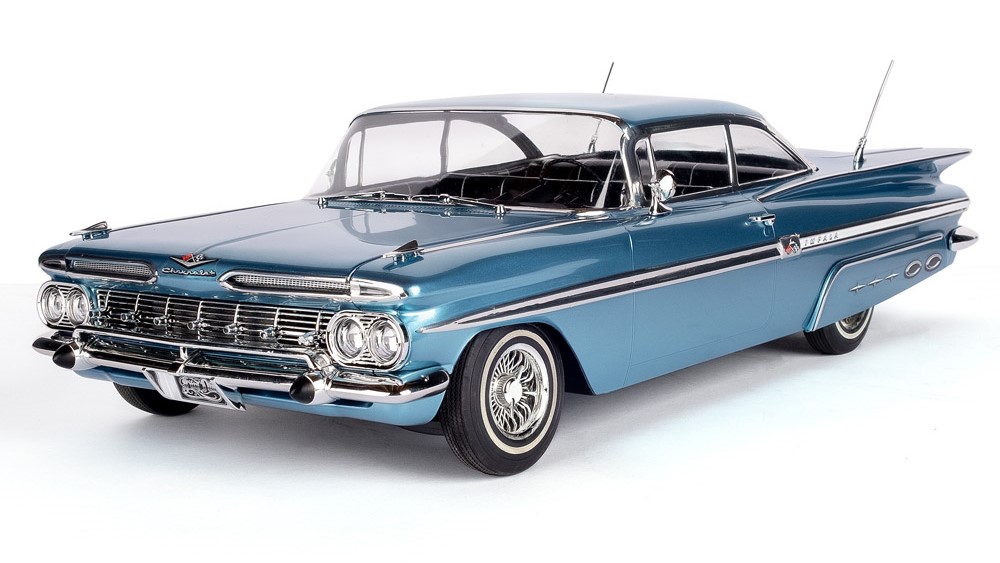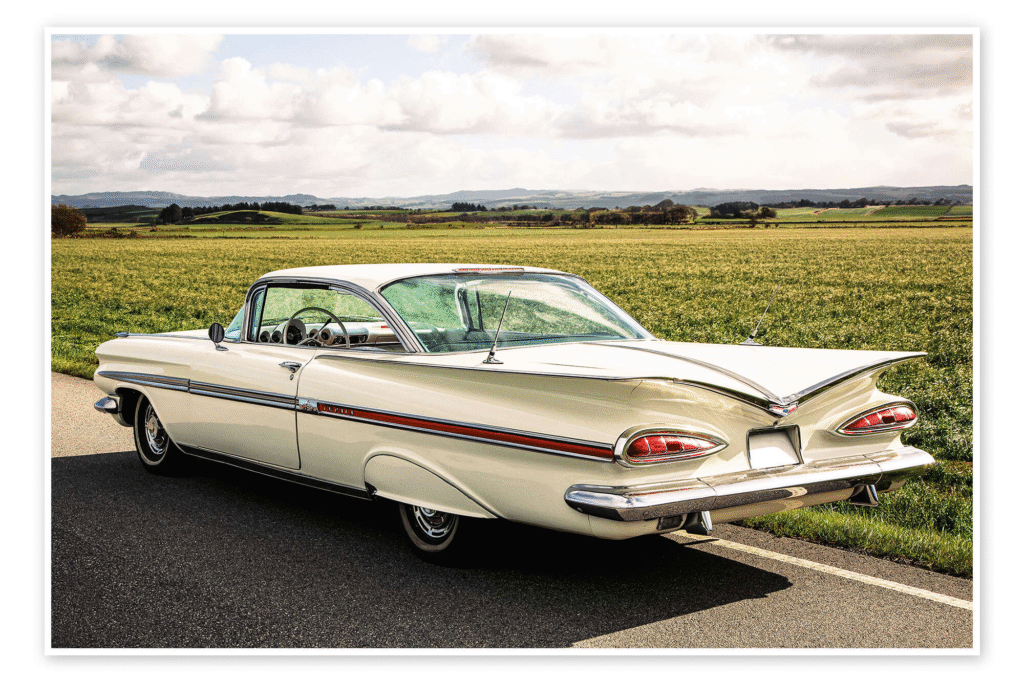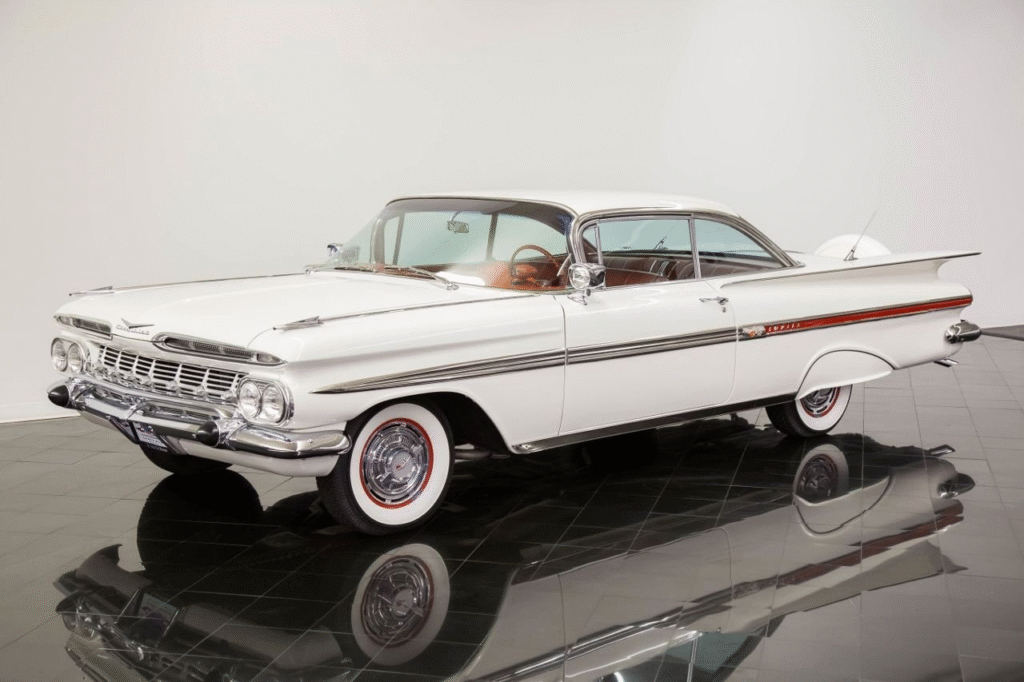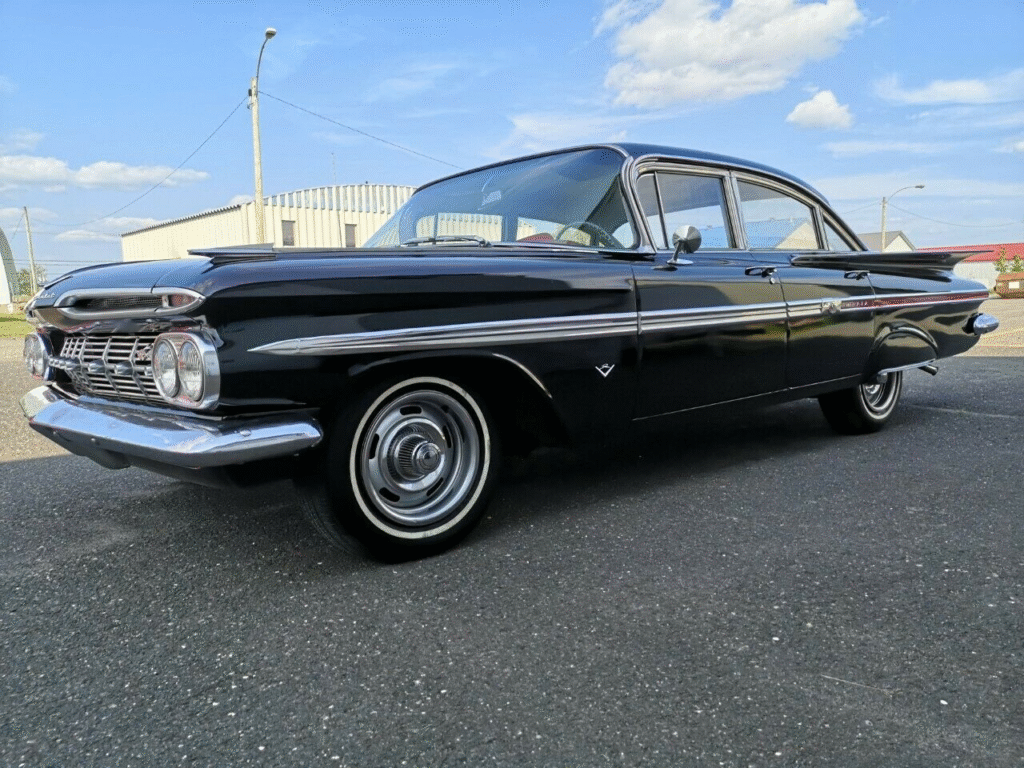Table of Contents
Toggle
There’s something magical about catching a glimpse of a 1959 Chevrolet Impala cruising down the street. Those distinctive bat-wing rear fenders, the gleaming chrome, and the unmistakable cat-eye taillights instantly transport you to an era of American optimism and prosperity. I’ll never forget the first time I encountered one at a small-town car show in the Midwest—standing before that glistening Crown Sapphire blue beast, I felt like I was looking at a landed spaceship rather than an automobile.
The ’59 Impala isn’t just another classic car; it’s arguably the most visually dramatic expression of America’s post-war confidence and the peak of Detroit’s “Jet Age” styling revolution. Having spent years restoring these beauties (and yes, occasionally cursing their complex trim pieces), I’ve developed a deep appreciation for what makes this particular model so special.
In this guide, we’ll explore everything that made the 1959 Chevrolet Impala a true American icon—from its revolutionary design and engineering innovations to its lasting cultural impact and modern collecting considerations. Whether you’re a seasoned collector, a restoration enthusiast, or simply someone who appreciates automotive history, buckle up for a comprehensive journey through one of Detroit’s finest hours.
The Birth of an Icon: Chevrolet’s Flagship Evolution
The name “Impala” derives from the swift African antelope known for its grace and speed—qualities Chevrolet hoped would be associated with their flagship model. Though many casual enthusiasts don’t realize it, the Impala nameplate actually made its first appearance in 1958 as the top-of-the-line Bel Air Sport Coupe. It wasn’t until 1959 that the Impala became its own distinct series in the Chevrolet hierarchy.
The transformation from the relatively conservative 1958 model to the revolutionary 1959 design represents one of the most dramatic year-over-year styling changes in automotive history. General Motors’ design chief Harley Earl wanted to create something truly spectacular for his final production design before retirement.
“The ’58 to ’59 redesign wasn’t just an update—it was a complete reimagining of what an American car could be,” automotive historian Robert Matthews told me during a restoration project we collaborated on. “It was a high-stakes gamble that paid off spectacularly.”
Within the broader General Motors lineup, the ’59 Impala established Chevrolet’s position as a brand that could offer near-luxury styling at a middle-class price point. This strategic positioning helped Chevrolet dominate the full-size automobile market at a time when foreign imports were beginning to make inroads into the American market.
Revolutionary Design: The Epitome of Jet Age Styling
If any single car captures the exuberant spirit of late-1950s America, it’s the 1959 Impala. The design team led by Harley Earl created a vehicle that embodied America’s fascination with jet aircraft, space exploration, and unlimited technological progress.
Those Unforgettable Rear Fins
The most distinctive feature—those dramatic rear “bat wings” with their cat-eye taillights—remains one of the most recognizable automotive design elements ever created. Unlike the tall, pointed tailfins of Cadillacs from the same era, the Impala’s horizontal fins created a sense of width and stability while still evoking the jet age aesthetic.
“The engineering team actually had concerns about whether those rear fenders could be manufactured,” retired GM designer Tom Peters once confided during a classic car symposium I attended. “But Earl insisted, and the production team eventually figured out how to stamp those complex curves.”

Front-End Styling
The front wasn’t nearly as radical as the rear, but still featured a distinctive wide grille with a delicate pattern that stretched across the entire front end. The dual headlights tucked under “eyebrow” trim pieces created a cohesive design language with the taillights—a thoughtful detail that many owners don’t notice until it’s pointed out.
Interior Innovations
Inside, the 1959 Impala featured what many consider to be one of the most beautiful dashboards of the era. The symmetrical design with its glittering aluminum trim band created a panoramic impression that complemented the wrap-around windshield. The speedometer, housed in a half-circle pod, resembled a jet’s instrument panel—further reinforcing the aerospace influence.
Having personally restored several ’59 Impala interiors, I can attest that the attention to detail extended to every aspect of the cabin. The upholstery patterns, door panels, and even the steering wheel showed a level of design thought that’s rare in modern vehicles.
Engineering Excellence Under the Hood
While the styling gets most of the attention, the 1959 Impala was also mechanically innovative. Chevrolet offered a range of powertrains to suit different driving preferences and budgets.
Engine Options
The base engine was the reliable 235.5 cubic inch “Blue Flame” inline-six producing a modest 135 horsepower. But the real stars were the V8 options:
- 283 cubic inch small-block V8 (185-230 horsepower depending on configuration)
- 348 cubic inch “W-series” big-block V8 (250-315 horsepower)
- The rare Tri-Power 348 with three two-barrel carburetors (335 horsepower)

I once had the opportunity to rebuild a Tri-Power 348 for a client’s restoration, and the engine’s massive torque and distinctive exhaust note make it one of my favorite powerplants from the era. Though not as celebrated as the later 409, these engines were robust performers that could push the nearly two-ton Impala to impressive speeds.
Transmission Choices
Buyers could choose from:
- Three-speed manual transmission (column-shifted)
- Four-speed manual (rare option)
- Two-speed Powerglide automatic
- Triple-turbine Turboglide automatic (complex but smooth when properly maintained)
In my experience, the Powerglide-equipped cars are the most common survivors today, as they provided a good balance of performance and reliability. The Turboglide, while innovative, had reliability issues that led many to be replaced with simpler transmissions over the years.
Ride and Handling
Contrary to what you might expect from such a large car, the ’59 Impala was actually quite composed on the road. Its X-frame chassis provided rigidity, while the suspension—featuring coil springs all around—delivered what period advertisements called a “Magic-Mirror ride.”
Having driven numerous examples over the years, I can confirm that a properly maintained ’59 Impala with modern radial tires and refreshed suspension components handles remarkably well for its size. As one owner colorfully told me, “It rides like a cloud but corners like it knows what it’s doing.”
The Complete Impala Family: Models and Variations
The 1959 Impala wasn’t just a single model but a family of vehicles catering to different preferences and budgets.
Body Styles
Chevrolet offered the Impala in four distinct body styles:
- Two-door Sport Coupe (hardtop) – The most iconic and collectible version
- Four-door Sport Sedan (hardtop) – Family-friendly but with pillarless styling
- Four-door Sedan (with B-pillars) – The most conservative and affordable option
- Convertible – The flagship of the line and now the most valuable


Each body style maintained the distinctive Impala styling cues while offering different practical advantages. The four-door Sport Sedan, with its hardtop design, offered the practicality of rear doors without sacrificing the open greenhouse effect when all windows were lowered.
Colors and Options
The 1959 model year offered an extraordinary palette of 15 solid colors and 36 two-tone combinations. From the vibrant Frost Blue to the elegant Corona Cream, these colors perfectly complemented the car’s flamboyant styling.
Interior options were equally diverse, with choices ranging from durable cloth-and-vinyl combinations to the premium all-vinyl “leather-grained” upholstery. Pattern options included the standard “string” pattern cloth, the more upscale “banjo” pattern, and several vinyl designs.
Factory options included:
- Power steering and brakes
- Air conditioning (rare and highly desirable today)
- Power windows and seats
- “Speedminder” speed alert system
- The luxurious “Flexomatic” six-way power seat
- Continental kit (rear-mounted spare tire)
I once documented a restoration of a ’59 Sport Coupe with the ultra-rare combination of factory air conditioning and the Continental kit. Finding correct parts for these rare option combinations can be a years-long treasure hunt that’s both frustrating and rewarding.
The Impala in American Culture: A Symbol of Prosperity
More than just transportation, the 1959 Impala became a cultural touchstone—a rolling symbol of American prosperity and technological optimism.
Media Presence
From its contemporary appearances in films and television to its continued presence in movies set in the late 1950s, the ’59 Impala has maintained a constant presence in American visual culture. Its distinctive silhouette makes it instantly recognizable even to those who aren’t car enthusiasts.
The connection between the ’59 Impala and the UFO phenomenon—highlighted in your competitor’s article about the Betty and Barney Hill abduction case—shows how deeply this car has embedded itself in American mythology. Its futuristic styling made it the perfect automotive companion for stories about alien encounters and other space-age phenomena.
Influence on Custom Car Culture
The 1959 Impala also holds a special place in custom car culture, particularly within the lowrider community. The car’s dramatic lines and generous chrome made it a perfect canvas for customization.
“No other car defines the lowrider aesthetic like the ’59 Impala,” custom car builder Javier Rodriguez explained during a show where his meticulously customized example took top honors. “Those lines were already dramatic from the factory—we just emphasize what was already there.”
Collecting and Owning a ’59 Impala Today
For those considering adding a 1959 Impala to their collection, there are several important factors to consider.
Market Value and Investment Potential
Values for the 1959 Impala have steadily appreciated over the past decade, with particularly desirable configurations (convertibles and Sport Coupes with big-block engines) seeing the strongest growth. As of 2025, values range from around $40,000 for a solid four-door sedan to well over $150,000 for concours-quality convertibles with rare options.
In my experience advising collectors, the sweet spot for enjoyable ownership is often a well-maintained driver-quality Sport Coupe. These provide the iconic styling without the anxiety that comes with owning a six-figure show car.
Restoration Challenges
Restoring a ’59 Impala presents unique challenges due to its complex trim pieces and body design.
“Those rear fenders aren’t just visually complicated—they’re challenging to repair correctly,” explains restoration specialist Mike Hanson. “Finding original trim in good condition is getting harder every year, and reproduction parts don’t always match the quality of GM’s originals.”
One particular pain point I’ve encountered repeatedly is the complex wrap-around windshield. The rubber seals are difficult to replace correctly, and leaks are common in improperly restored examples. Budget accordingly if your project car needs glass work.
Parts Availability
The good news for owners is that mechanical parts remain widely available thanks to the Impala’s popularity and mechanical commonality with other Chevrolet models. Engine and drivetrain components are readily available, and performance upgrades abound for those who want modern driveability without sacrificing the vintage appearance.
Body and trim parts present more of a challenge, though specialized vendors have stepped in to reproduce many components. The most difficult items to source are often interior pieces and pot metal trim items that tend to deteriorate over time.
The ’59 Impala Legacy: Why It Remains Timeless
What makes the 1959 Impala endure as an object of fascination while some of its contemporaries have faded into obscurity?
Design Influence
The ’59 Impala represents the peak of a design language that would soon give way to the more restrained styling of the 1960s. Its exuberance captured a specific moment in American culture—the last gasp of unbridled post-war optimism before the more tumultuous 1960s.
Comparing the ’59 Impala to its competitors reveals just how forward-thinking Chevrolet’s design team was. While the 1959 Ford Galaxie featured more conservative styling, and the Plymouth Fury split the difference with moderate tailfins, the Impala went all-in on futuristic design elements that still look distinctive today.
Generational Appeal
Perhaps most surprisingly, the ’59 Impala continues to attract younger enthusiasts who weren’t alive when these cars ruled American highways. At recent car shows, I’ve noticed more millennials and even Gen Z enthusiasts gravitating toward these cars than ever before.
“There’s something authentic about the ’59 that speaks to people regardless of when they were born,” observes classic car insurance specialist Jamie Winters. “It represents an unabashed American confidence that transcends nostalgia.”
Conclusion
The 1959 Chevrolet Impala stands as more than just a classic car—it’s a rolling sculpture that captured the spirit of an era. Its outrageous styling, comprehensive model range, and strong mechanical foundation created a package that continues to captivate enthusiasts more than six decades after it first shocked the automotive world.
Having spent countless hours under, inside, and behind the wheel of these magnificent machines, I’ve developed a profound respect for what the ’59 Impala represents: the courage to design something truly daring, the engineering skill to make it work, and the cultural impact that ensures its immortality.
Whether you’re attracted to its jet-age styling, its historical significance, or simply the joy of cruising in an automotive icon, the 1959 Chevrolet Impala remains one of the most significant vehicles in American automotive history. In a world of increasingly homogenized design, the ’59 Impala stands as a chrome-laden reminder of a time when Detroit dared to dream big—and had the confidence to park those dreams in American driveways.
Frequently Asked Questions
How many 1959 Chevrolet Impalas were made?
Chevrolet produced approximately 473,000 Impalas across all body styles for the 1959 model year. The four-door hardtop was the volume leader with about 182,000 units, followed by the Sport Coupe with approximately 164,000 units. Convertibles were the rarest, with just under 72,000 produced.
What makes the 1959 model different from other Impala years?
The 1959 model year represents the most dramatic styling of any Impala, with its distinctive horizontal “bat wing” fins and cat-eye taillights. The 1960 redesign would introduce more conservative styling, making the ’59 a one-year-only design phenomenon.
Are 1959 Impalas good daily drivers?
With appropriate updates to the braking system, cooling system, and electrical components, a ’59 Impala can be a surprisingly practical classic. However, fuel economy (typically 8-12 MPG), limited safety features, and parts availability should be considered before daily use.
What are the most valuable 1959 Impala configurations?
The hierarchy of value, from highest to lowest, typically falls in this order:
- Convertible with fuel-injected or Tri-Power V8
- Sport Coupe with Tri-Power V8
- Standard Convertible with V8
- Sport Coupe with regular V8
- Four-door models
Factory air conditioning, original fuel injection systems, and documented rare color combinations can significantly increase value across all body styles.

